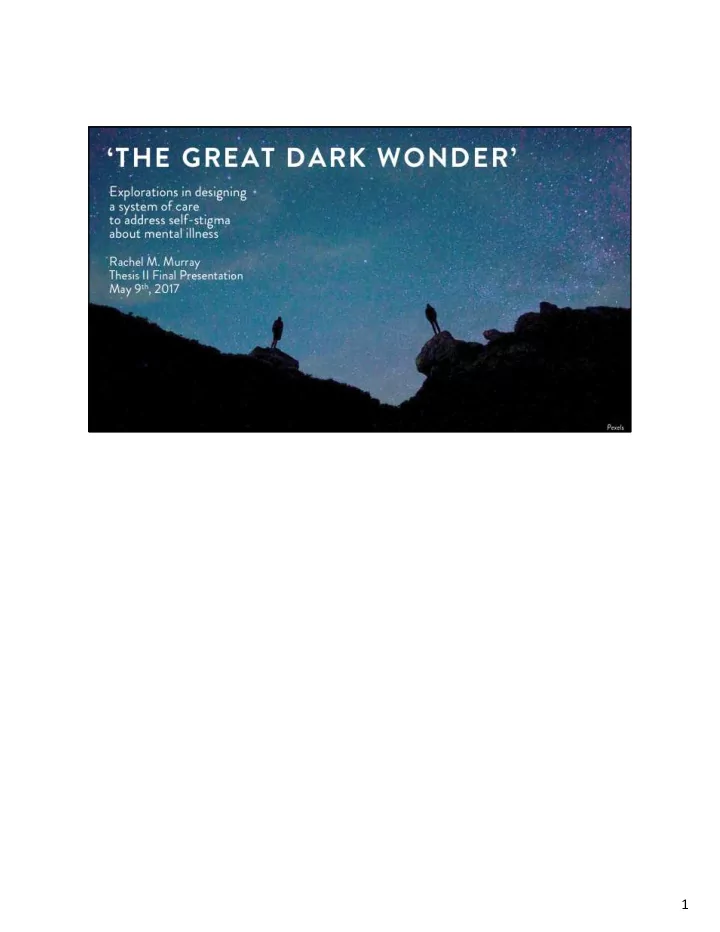

1
2
How do we stop the negative stories of mental illness as violent nutso, in particular? 3
4
5
Read social thesis etc. and today’s focus will be project and prototypes. Show you prototypes that led to project 6
Knowing so many systems challenges… 7
8
9
10
11
Knowing we require systemic changes and cultural change to address stigma and mental health, how might we use a recovery-oriented approach to address gaps in care around self-stigma ? I believe that a ‘cultural infrastructure’ of design interventions can address those gaps and help prevent moments of self-stigma. Self-stigma and public stigma - will be tackled when we create the infrastructure and ‘scaffolding’ to dismantle them. We can expand Benjamin Bratton’s Stack as a framework of how to build such infrastructure via Lighthouse. 12
Knowing so many systems challenges… 13
I’ve been inspired by Benjamin Bratton’s ‘Stack’, from user to Earth, and wanted to extended this out – using my hypothesis as my guide, but also as this metaphor of cultural infrastructure. So I identified issues and applicable theories and shaped my design interventions. 14
When we extend the stack out we start to touch on where stigma lives - 15
And so my work looked at some of the issues, found applicable theories and then mapped out design interventions along it. 16
To understand the design interventions, there are three parts of what I’ve designed – the ‘core’, the ‘IP’ or uniqueness, and the future vision. Core – some of the basics for a service – digital infrastructure, manifesto or philosophy behind it, and onboarding guide into the system IP – uniqueness of this work – activities peers lead, peers leading (role), evocative objects and the recovery plan documents Future vision – commitment to living service 17
To give you a better sense of how this works, I’ll walk you through a light level scenario – I’ve done customer journey map and biz model canvas and all that you can view at my exhibit, but this is the basics of how the system works, and then I’ll dive into a few key touchpoints. 18
19
(read grey column) 20
21
Vase with story I discuss in my thesis book 22
Knowing so many systems challenges… 23
24
Don’t say didn’t build out. 25
Using communication design with paper to push recovery oriented content 26
• This is a fictionalized story is Isaac, with Bipolar I disorder, and his journey with key moments in treatment. • There’s not often this ‘longitudinal’ view on illness in the stories, but they’re important to share as well – from 18 to 33. It also taught me copy matters as much as the visuals • I also used the ThriveNYC brand while I worked out the branding possibilities of who would deliver the service – it’s the City of NYC strategic plan to address mental illness • I see this as where peer to peer support and recovery come in – so accompanying infrastructure to capture stories via a volunteer peer-to-peer support to manage and run it, tailored to different conditions. • While each illness and experience is unique, this is an opportunity from the start to instill some connection via peer to peer support to reduce isolation 27
• This all maps to key recovery oriented content – treatment plan, goals, care kit, resources, etc. While recovery oriented means treatment should be tailored to Isaac’s unique situation, seeing someone like Isaac can set forth a new narrative that mental illness is not mad/bad/sad. • Resources could be tailored by geography – so in this case the Bronx • The psychiatrist I ran this by found it was key – there’s a move to show more culturally competent, diverse materials, and could be customized for various conditions, and expanded as necessary. FEEDBACK FROM USERS: 28
• Cultural competency is important - there’s a move to embed this in healthcare, and customization here works. The psychiatrist I ran this by found it was key because we know targeted interventions that address specific groups – like the city’s outreach about postpartum depression matters • Cost points to implementation – still a role for paper, which helped make this successful • Reducing isolation at onboarding – having an ‘Isaac’ - is an ingredient of social cohesion. The idea of ‘onboarding’ is an important pain point – key for reframing. I had someone who responded to my note in the school, and he said even seeing someone researching the topic made him feel like he was less alone. What we can do to reduce isolation provides wellbeing 28
Using communications design but working to integrate design to objects and exploring personalization 29
Using more product design to push 30
Using the physical design of boxes to again use design to make visible and embed recovery 31
Using design to materialization a concept – in this case, using narrative written on an object to make it ‘more’ evocative 32
Future possibilities 33
34
Knowing so many systems challenges… 35
36
37
38
Recommend
More recommend